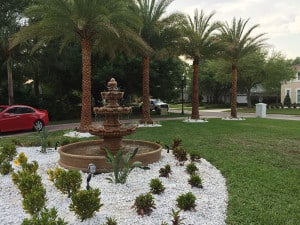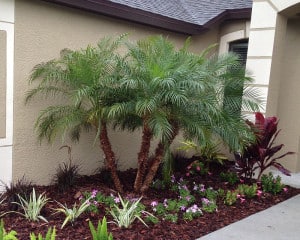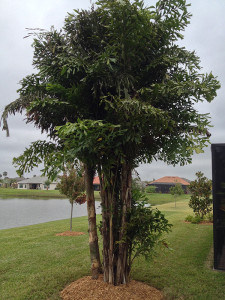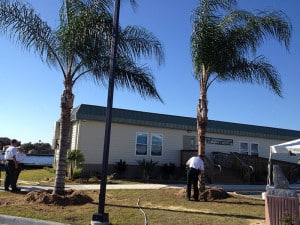Palms
Canary Island Date Palm
 The Canary Island Date Palm Tree (Phoenix canariensis) are native to the Canary Islands which are located in the Atlantic Ocean off the coast of northeast Africa. The Cold hardy Canary Island Date Palm Trees are popular landscape items in near warm climates around the world. The Canary Island Date Palm has been utilized as a theme for generating focal points in landscapes worldwide for decades. Its majesty and substantial presence make the Canary Island Date Palm a powerful choice where you a looking to bring natural maturity to a site. Utilized in rows or as a freestanding centerpiece, there really aren’t many locations on site where you cannot use Canary Island Date palms successfully. Probably the best adjective that one could use to describe Canariensis is Stunning.
The Canary Island Date Palm Tree (Phoenix canariensis) are native to the Canary Islands which are located in the Atlantic Ocean off the coast of northeast Africa. The Cold hardy Canary Island Date Palm Trees are popular landscape items in near warm climates around the world. The Canary Island Date Palm has been utilized as a theme for generating focal points in landscapes worldwide for decades. Its majesty and substantial presence make the Canary Island Date Palm a powerful choice where you a looking to bring natural maturity to a site. Utilized in rows or as a freestanding centerpiece, there really aren’t many locations on site where you cannot use Canary Island Date palms successfully. Probably the best adjective that one could use to describe Canariensis is Stunning.
Foxtail Palm
 A tropical showstopper in the landscape, the foxtail is available in single or multi-trunk specimens. Its smooth gray trunk is topped with a bright green crownshaft and big tufted fronds that resemble the bushy tail of a fox. The charismatic beauty of this palm works in almost any landscaping. These palms like plenty of sunshine and they’re moderately drought-tolerant once established, though a regular watering is ideal. The foxtail is a moderately salt-tolerant palm and it’s self-cleaning (old fronds fall off by themselves).
A tropical showstopper in the landscape, the foxtail is available in single or multi-trunk specimens. Its smooth gray trunk is topped with a bright green crownshaft and big tufted fronds that resemble the bushy tail of a fox. The charismatic beauty of this palm works in almost any landscaping. These palms like plenty of sunshine and they’re moderately drought-tolerant once established, though a regular watering is ideal. The foxtail is a moderately salt-tolerant palm and it’s self-cleaning (old fronds fall off by themselves).
Sylvester Palm
 Palms are known for adding a tropical ambiance wherever they are found. Plant a Sylvester Palm tree, and create your very own tropical getaway. The Sylvester Palm tree is native to southern Pakistan, most of India and Bangladesh. They are quite hardy, easy to grow and are resistant to many diseases common to other types of palms. They also require little to no maintenance. Because of this, a Sylvester Palm would make a great addition alone in a single pot, or planted in small grouping of 3-5 trees.
Palms are known for adding a tropical ambiance wherever they are found. Plant a Sylvester Palm tree, and create your very own tropical getaway. The Sylvester Palm tree is native to southern Pakistan, most of India and Bangladesh. They are quite hardy, easy to grow and are resistant to many diseases common to other types of palms. They also require little to no maintenance. Because of this, a Sylvester Palm would make a great addition alone in a single pot, or planted in small grouping of 3-5 trees.
Bismarck Palm
 The Bismarck palm has a stout trunk and a huge crown of the large, symmetrical, fan-shaped, stiff, waxy, blue-grey fronds. The Bismarck palm looks very attractive as a single specimen or when several trees placed together. This magnificent palm is a perfect specimen for medium to large residential yards, parks, gardens and avenues. The Bismarck palm is native to Madagascar and suitable for sub-tropical climates. The impressive specimen is a fairly fast grower. It looks the best when grows in full sun and well drained sandy soil.
The Bismarck palm has a stout trunk and a huge crown of the large, symmetrical, fan-shaped, stiff, waxy, blue-grey fronds. The Bismarck palm looks very attractive as a single specimen or when several trees placed together. This magnificent palm is a perfect specimen for medium to large residential yards, parks, gardens and avenues. The Bismarck palm is native to Madagascar and suitable for sub-tropical climates. The impressive specimen is a fairly fast grower. It looks the best when grows in full sun and well drained sandy soil.
Royal Palm
 The Royal Palm is native to Cuba and North America. Royal Palms are popular in many warm, coastal landscapes, particularly in southern Florida and parts of California. They can be also found in the Caribbean, Central and South American, and Texas. The grace and beauty of a Royal Palm makes it a popular tree along the streets of many cities. Often they are used in the islands of large parking lots or in medians along the highway. Nothing says “tropical” like the majestic Royal Palm!
The Royal Palm is native to Cuba and North America. Royal Palms are popular in many warm, coastal landscapes, particularly in southern Florida and parts of California. They can be also found in the Caribbean, Central and South American, and Texas. The grace and beauty of a Royal Palm makes it a popular tree along the streets of many cities. Often they are used in the islands of large parking lots or in medians along the highway. Nothing says “tropical” like the majestic Royal Palm!
Robellini Palm
 The Robellini Palm could be an ideal tree for anyone who wants a palm tree in their yard or garden, but does not have room for a very large palm tree. The little palms rarely grows more than 12 feet tall, and sometimes only reaches half of that height. The Robellini is a date palm and because of its small size it is often referred to simply as a pygmy date palm.
The Robellini Palm could be an ideal tree for anyone who wants a palm tree in their yard or garden, but does not have room for a very large palm tree. The little palms rarely grows more than 12 feet tall, and sometimes only reaches half of that height. The Robellini is a date palm and because of its small size it is often referred to simply as a pygmy date palm.
Bottle Palm
 The beautiful striking Bottle Palm tree is a very unique palm because of the rather large bulge of the trunk. The Bottle Palm is very slow growing and adds flavor with uniqueness to any setting. The most distinguishing feature of the Bottle Palm is the bulged section of its trunk. This bulged section changes in colors throughout its life from gray, green, and even purple. The Bottle Palm Tree enjoys full sun and does best with sandy, good draining soil. The Bottle Palm is not cold hardy and will not tolerate frost. The Bottle Palm is usually the center of attention and a conversation starter in any garden or home.
The beautiful striking Bottle Palm tree is a very unique palm because of the rather large bulge of the trunk. The Bottle Palm is very slow growing and adds flavor with uniqueness to any setting. The most distinguishing feature of the Bottle Palm is the bulged section of its trunk. This bulged section changes in colors throughout its life from gray, green, and even purple. The Bottle Palm Tree enjoys full sun and does best with sandy, good draining soil. The Bottle Palm is not cold hardy and will not tolerate frost. The Bottle Palm is usually the center of attention and a conversation starter in any garden or home.
Fishtail Palm
 Fishtails are clustering palms that grow dense and full. They can be used as privacy screens – especially while they’re young – and create a draping mass of deep green leaves among large trunks as they age. Many homeowners opt for growing a fishtail in an area where they’ve been considering bamboo – it won’t spread as much or as fast, but gives the same kind of tropical look and privacy.
Fishtails are clustering palms that grow dense and full. They can be used as privacy screens – especially while they’re young – and create a draping mass of deep green leaves among large trunks as they age. Many homeowners opt for growing a fishtail in an area where they’ve been considering bamboo – it won’t spread as much or as fast, but gives the same kind of tropical look and privacy.
Areca Palm
 The Areca Palm, is a beautiful palm tree from Madagascar. It is a common ornamental in subtropical and tropical regions around the world. Probably it is the most cultivated nursery palm tree. The adult palm has several smooth, bamboo-like trunks that gently lean away from each other. Young plant has reedy stems. The multi-trunked specimen plant has attractive long gracefully arching feather-shaped fronds. This palm is very good at providing a screen for privacy
The Areca Palm, is a beautiful palm tree from Madagascar. It is a common ornamental in subtropical and tropical regions around the world. Probably it is the most cultivated nursery palm tree. The adult palm has several smooth, bamboo-like trunks that gently lean away from each other. Young plant has reedy stems. The multi-trunked specimen plant has attractive long gracefully arching feather-shaped fronds. This palm is very good at providing a screen for privacy
Queen Palm
 This stately, single-trunked palm is crowned by a beautiful head of glossy, bright green, soft, pinnate leaves forming a graceful, drooping canopy. It is popular in home landscapes as a focal point or to frame a house. In commercial landscapes, Queen Palms can be planted in rows on 15-foot centers to line a street or walk, or in clusters or occasionally as a specimen. The grey trunk is ringed with old leaf scars.
This stately, single-trunked palm is crowned by a beautiful head of glossy, bright green, soft, pinnate leaves forming a graceful, drooping canopy. It is popular in home landscapes as a focal point or to frame a house. In commercial landscapes, Queen Palms can be planted in rows on 15-foot centers to line a street or walk, or in clusters or occasionally as a specimen. The grey trunk is ringed with old leaf scars.

